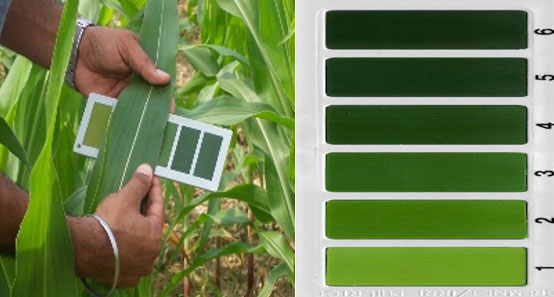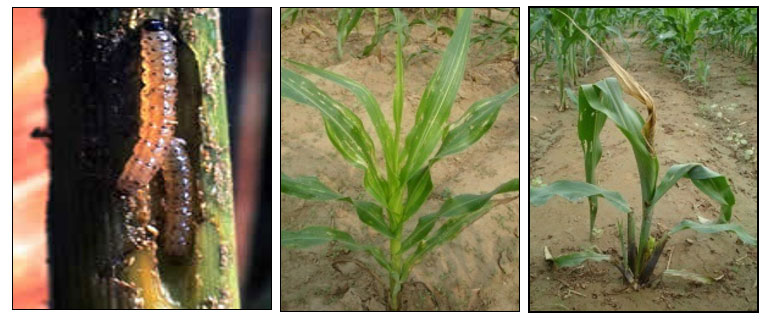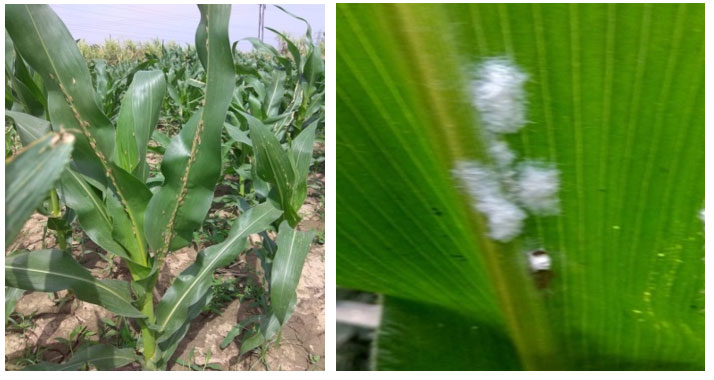- Complete Package of practices for Kharif & Rabi maize cultivation in Punjab
- Recommendation of Autumn planting of maize during second fortnight of August
- Complete Package of practices for baby corn cultivation in Punjab
- Complete Package of practices for spring maize cultivation in Punjab
- Recommendation on Bed/Ridge sowing of maize to avoid the adverse effect of excess rainfall, particularly at seedling emergence, sow the maize seed 3-5 cm deep on top centre of the bed with row to row spacing of 67.5 cm and plant to plant spacing of 18 cm or sowing should be done preferably 6-7 cm above base on the side of ridges spaced 60 cm with plant to plant spacing of 20 cm. Wheat bed planter can be used for bed preparation.
- Recommendation on effective weed control by Spraying 800 g per acre Atrataf/Atragold/Masstaf/Atari/Traxx 50 WP (atrazine) on medium to heavy textured soils and 500 g/acre in light soils within ten days of sowing, using 200 litres of water or spray 250 g per acre atrazine over the crop rows on 20 cm wide band over the crop rows followed by hoeing/interculture at 15 to 30 days after sowing. T
- 2,4-D Amine salt 58% as post emergence for control of Cyperus rotundus
- Recommendation on spray 105 ml per acre Laudis 420 SC (tembotrione) in 150 litres of water at 20 days after sowing for effective control of mixed weed flora.
- Recommendation of leaf colour chart (LCC)- need based ‘n’ fertilizer application in maize
- Seed treatment with Gaucho 600 FS (imidacloprid) @ 6 ml per kg seed recommended for the control of shoot fly in spring maize

Maize stem borer, Chilo partellus: The newly hatched larvae attacks maize in the early whorl stage causing scrapping and pin hole injury. In younger plants, the central shoot dries up resulting in ‘deadheart’ formation. In advanced stages of plant growth (> 45 days) the infestation of borer may cause reduction in plant growth but rarely cause complete loss of plant. The larvae may tunnel the developing cobs and sometimes make galleries by feeding on the pith and grains.

Management:
- Release egg parasitoids, Trichogramma chilonis on 10 and 17 days old crop. Use trichocards having 40,000 T. chilonis parasitized eggs of Corcyra cephalonica per acre for one release.
- Removal and destruction of plants with severe borer injury at hoeing.
- Spray Coragen 18.5 SC (chlorantraniliprole) @ 30 ml/acre using 60 litres water per acre with knapsack sprayer at the appearance of leaf injury symptoms on 2-3 weeks old crop is most beneficial.
Fall armyworm, Spodoptera frugiperda: The young larvae feed by scrapping the leaf surface making papery windows. The bigger larvae feed voraciously on the central whorl leaves causing round to oblong holes and produce a large amount of faecal matter. The larva can be identified by predominant white-coloured inverted Y-shaped mark on the head and presence of four spots arranged in square pattern at the tail end.

Management:
- To limit multiplication and spread fall armyworm, sow the grain crop in recommended time only and prefer to sow the crop mid- April to mid-August.
- Prefer mixed cropping of fodder maize with cowpea/ bajra/ sorghum.
- Use recommended seed rate (30 kg/acre) and follow line sowing method rather than broadcasting.
- Avoid staggered sowing of maize in adjacent fields to minimize spread of this pest.
- Spray the grain crop with Coragen 18.5 SC (chlorantraniliprole) @ 0.4 ml/ litre or Delegate 11.7 SC (spinetoram) @ 0.5 ml/ litre or Missile 5 SG (emamectin benzoate) @ 0.4g/ litre using 120 litres of water per acre, for crop up to 20 days old. Thereafter, the amount of water used per acre needs to be increased up to 200 litres with corresponding increase in dosage of above insecticides. For effective control, direct the nozzle towards the whorl.
- For fodder crop spray with Coragen 18.5 SC (chlorantraniliprole) @ 0.4 ml/ litre and do not harvest fodder for 21 days spray to ensure safety to farm animals.
Shoot fly, Atherigona naqvii: It infests the spring sown maize. The crop at seedling stage (4-12 days) is most susceptible to shoot fly attack. Newly hatched maggots (leg less larvae) of shoot fly enter through leaf sheath, reached the stem and cut the growing point. The infested plants are deformed and central shoot form tube like structure, which dries to form deadhearts. The attack on bigger plants results in curling and distortion of the leaves.

Management:
- Treat the seed with Gaucho 600 FS (imidacloprid) @ 6 ml /kg seed. The treated seed should be used within 14 days of treatment.
- If somehow seed treatment is not possible only then Apply Furadan 3G (carbofuran) @ 5 kg per acre at sowing.
- The sowing of spring maize during recommended time i.e. 20 January to mid February is helpful in escaping the peak period of shoot fly incidence.
Silk cutter, Helicoverpa armigera:
Adult moth lays eggs on tassels and silks of maize. The young larvae feed on tassels, silks and may tunnel in ears and damage the grains in milky stage. The attacked ears show masses of moist excreta on them, thus lower its market value as green cobs.
Management:
- Sow the crop in recommended time only.
- If incidence of silk cutter is high then use the pesticides recommended against the maize borer
Armyworm Mythimna spp. : The larvae feed the margins and then move inward; larvae may eat entire leaves, leaving only the midribs. Under severe infestation, the entire young plant may be consumed.
Management: The pesticides used against the maize borer are effective in controlling these pests also.

Hairy caterpillars:
Hairy caterpillars, appearing in an epidemic form may cause serious damage by feeding on the leaves and the tender stems. When young, they feed gregariously. The grown up caterpillars may migrate from one field to another.
Management:
- Use light traps for the destruction of moths
- Young larvae are gregarious. They can be destroyed by plucking the infested leaves or by pulling out the infested plants and burying them underground.
- The grown up caterpillars can be destroyed by crushing them under feet or by picking and putting them into kerosenized water.
Leaf feeding insect pests like jassid, thrips, pyrilla, grey weevil and grasshoppers: These are polyphagous pest occurring on a number of crops like cotton, sorghum, pearl millet and maize all over India. Occasionally these insect assumes serious proportions on the crop. Follow clean cultivation and conserve the natural enemies of the pests.


